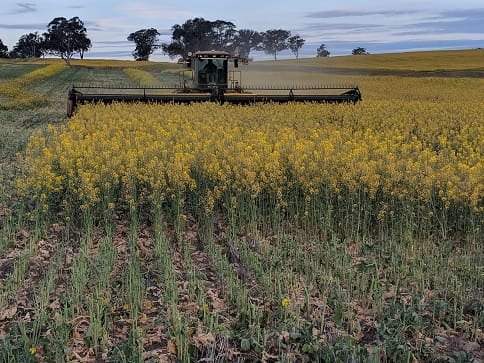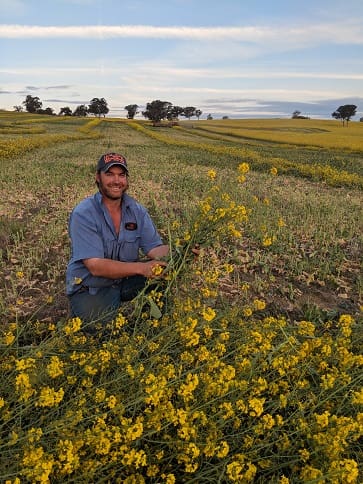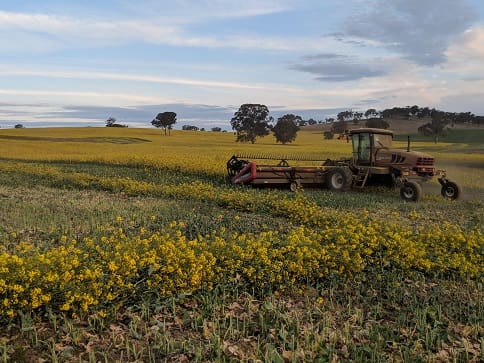
Southern NSW grower, James Burge, this week cut 150 hectares of drought-affected canola for hay on his Cootamundra farm.
MAKING decisions early will help minimise income losses in a drought-impacted year like the one affecting eastern Australia at the moment, according to southern New South Wales mixed farmer James Burge.
“This is our one-in-10 drought year, and we expect that. It is not a surprise or a shock, we just have to manage it,” he said.
“I like to make decisions early and get them going – sometimes people don’t know what decision to make so they don’t make one, and then it does become a bit late and becomes hard for them.”
His property, Windella, near Cootamundra has received just 264 millimetres of rain this year, about half the average, and very little of that has been in the crop growing season.
A fortnight ago he made the decision to cut 150 hectares of his canola crop for hay, leaving just 50ha to harvest for seed. This week the mower went into the paddock.
“It has just run out of moisture so we made the decision to cut it for hay while it still had some leaf and moisture – try to make that call early to get something out of it instead of harvesting later,” Mr Burge said.
“I saw an opportunity with the drought in the north and west, a lot of people are looking for hay, and even around us people are looking for hay and silage to get through – having a dry spring is tough around here as we are coming into a dry summer and often it can be a late autumn break.
“It was an easier decision to make because we know we can get something for it, not as much as taking it through to seed but more than taking it through to harvest and potentially getting nothing.”

Southern NSW grower, James Burge, took the decision early to turn some of his drought-affected crops into fodder.
Rainfall deficit
Making the decision early will also mean the hay is better quality for Mr Burge’s sheep flock, which will be the focus for on-farm income after so little rain this year.
“Our in-crop rainfall has been very light this year, we just haven’t got the rainfall since sowing, we sowed a lot of crop dry and then had falls of 5-15mm of rain when we needed 20mm in those falls,” Mr Burge said.
“But the big one is we haven’t had it in the past month, and that has prompted the decision and to be honest it doesn’t look like it is going to rain for the next month, which means we weren’t going to get anything at harvest.”
Mr Burge also has a contract harvest and trucking business. He said they would try to take the opportunities where they arose to make and handle hay to make up for what they would miss out on in a usual crop harvest – but their yearly income would still be “a lot less than normal”.
Provided everything was done correctly, Mr Burge said canola hay had good protein and energy for stock, and while it wouldn’t be as profitable as the canola seed itself, making the decision to cut it early meant it would still be very saleable.
“Farmers will find the decision to cut hay this year easy. A lot of farmers around here cut canola for hay in 2006-07, and back then there wasn’t the demand for it,” he said.
“And because we hadn’t done it before no one knew what the outcome would be in terms of quality and saleability, so it was a hard decision to make. But now it has been done before and there is a demand for hay, it is still a hard decision but it’s easier than it has been.”
Stock to benefit
Windella is a 50-50 livestock-cropping operation in an average year, and a good lambing percentage – 160 per cent across the flock at marking – had given Mr Burge the stock needed to try to capitalise on failed crops.
As the season stands currently, Mr Burge is expecting to harvest 60pc of his 200ha of wheat, grazing the rest, and about 50pc of his 200ha of barley, but those harvest percentages would decrease if more rain wasn’t received in the next 10 to 14 days.
“We have plenty of lambs not quite ready to be weaned yet, so we will try to put them onto the crop that we are going to sacrifice, along with feeding them a bit of grain left on farm, because I feel that is where the money is going to come from rather than crops,” he said.
“The emphasis will be on getting them finished and off the place, they are second cross lambs so there is a good market if they are finished and big enough, and we need to get them off to be stocked a bit lighter going into autumn.
“We are lucky that although our cropping income will be right back, we will get some income, where people north and west of us won’t have any income, so I consider us very lucky, and I am hoping if we can finish our lambs well enough that income won’t be too much impacted and will help prop up the cropping side.”
Bird in the hand
Tumut based agronomist Mark Lucas said the decision-making model was pretty clear for those growing canola this year, with any crops not heavy enough to cut for hay having stock put on them already.
“Even if we did get enough rain to produce a grain or seed outcome, they would have probably failed on oil content, so they’ve said a bird in the hand is worth 10 in the bush – most people have gone in and taken the view that while the product is good they will make it into silage to maintain the quality of the product,” he said.
And many are leaning towards silage over hay for their canola, as the long drying time for any low yielding crop could cause quality issues.
“If you have a marginal dry matter yield, you are still able to break up a canola crop into silage, because you still have stem moisture, but if you let it go right through to the drying process for hay, you will make average hay from fracturing the plant,” he said.
Mr Lucas said while limited crops – such as oats – growing in high rainfall zones would be left to try to retrieve seed, a lot were already being cut for fodder or grazed.
“There is going to be very little seed for next year’s sowing. Most people had already grazed because they did not get sufficient development to get to the point of locking it up to go to grain. And because of the short cut spring everyone has under-finished lambs so that’s what is on those crops,” he said.
Widespread impact
Mr Lucas said the impact was quite widespread in southern NSW, with nowhere north of Holbrook getting a lucky break, but select crops close to the Victorian border still holding up.
But he said there was a silver lining as the livestock industry would benefit from the close proximity of available fodder, as a “serious deficit of feed” was going to occur in coming months.
“Canola hay will support sufficient nutrition for sheep and cattle to keep them alive – if fed right,” he said.
Mr Lucas said producers in NSW had used their on-farm stores of hay over winter, and were having to source it from areas of Victoria and South Australia, meaning if some canola crops weren’t made into hay or silage the livestock industry would be in “dire straits”.
So, while it was less than ideal for canola growers, it had been a positive for livestock producers who now had roughage available for cattle and sheep in southern NSW.
“Before if canola got hit by primarily frost then drought, and the livestock guys all had full haysheds they wouldn’t buy it – that is the one benefit of a bad situation, the canola guys are getting some income, and livestock guys have a roughage source in close proximity to where the livestock are – not interstate with a great big freight component.
“No one has really done the maths, but you don’t really have to be too smart to know that feeding $500/tonne grain to livestock isn’t going to work.”
………………………………………………………………………………………………………………………………………….
Checklist for making crop salvage decisions
FARMERS considering whether they should harvest their grain crops or cut them for hay this season now have a new tool from Agriculture Victoria to support their decision-making.
‘Cutting failed crops for hay or silage’ is a new fact sheet featuring a checklist for growers to help them make an informed choice about their crops.
The fact sheet complements the ‘hay versus grain calculator’ and ‘dry matter calculator‘ on the Agriculture Victoria website.
Agriculture Victoria regional manager, Robert O’Shannessy, said the key consideration for growers was the cost-benefit of cutting a crop or letting it go through to harvest.
“The calculators help growers estimate hay yields and work out their returns after expenses from hay, compared with expected returns from harvesting the grain,” he said.
“The complementary fact sheet highlights the factors to consider when estimating potential grains yields, including the available subsoil moisture levels and the weather forecast.
“Crop growth stage is critical as it has a major effect on both hay yield and quality.”
For growers with their own livestock, grazing is an option. Growers should be careful to maintain sufficient ground cover to minimise the risk of soil erosion.
Mr O’Shannessy said growers should research markets and end-users and remember that they might be required to supply vendor declarations when selling hay.
“It’s crucial that growers cutting crops for hay check chemical labels to ensure they comply with the withholding periods of chemicals used on the crop,” he said.
The fact sheet also provides hints for growers in engaging contractors for hay making and links to other useful resources.
Source: Agriculture Victoria
Grain Central: Get our free daily cropping news straight to your inbox – Click here


HAVE YOUR SAY